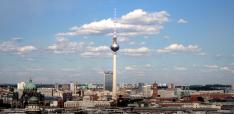G7 Protests: Washed out and Dry on Substance
This post represents the second in a series from the ongoing G7 summit being covered on the ground by the Global Leadership Initiative's team. Please check in regularly to keep up to date with the latest news and analysis from the summit.
The clashes between protesters and police at the G7 have dominated the media’s reporting ahead of the beginning of the actual summit. Whilst opposition to the existence of the summit seems to be a key motivator, the aims of protesters remain disparate and vague.
This has not always been the case. When Gerald Ford invited his fellow G7 leaders to San Juan, Puerto Rico in June 1976 for their second, impromptu summit, 15,000 protestors targeted the meeting with their very specific demand of Puerto Rican independence. Fast-forward almost a quarter of a century, 27,000 Okinawan protestors formed a human chain around a US airbase the day before the G8 summit began to highlight the disproportionate burden they shoulder relative to the rest of Japan in hosting US military bases. Examples abound of protestors grasping the opportunity afforded by a global summit to use the media attention to project their cause to a worldwide audience.
However, since the late-1990s, global summitry has been a magnet for protestors with a much more inchoate agenda that coalesces under the umbrella term of ‘anti-globalisation’. This ‘movement’ sees itself has holding the G7 to account, as well as questioning its legitimacy and sometimes its very right to meet. Its tactics are equally broad, ranging from the peaceful, such as holding alternative summits and marches, to the violent – the worst example being the black bloc tactics used during the 2001 Genoa Summit and the heavy-handed response of the Italian security forces that resulted in the shooting of twenty-three-year old protestor Carlo Giuliani.
The reality of the situation at the G7 this year is that the clashes between protesters and police have been minor. An overwhelming police presence has dominated the relatively low turnout of protesters, limiting the gains of the protesters to the blocking of an access road to Schloss Elmau. Major scuffles in the town of Garmisch-Partenkirchen have been avoided through an agreement between local businesses and protestors to avoid causing damage. Meanwhile, following the summer thunderstorm on Saturday night, the anti-G7 protest turned into more of a damp squib than a movement for change. With protesters huddled under an overpass for shelter and the police returning to their riot vans to dry out, it had the air of a postponement of the local cricket match rather than a struggle against oppression.
The G7 team: Garrett Wallace Brown, Hugo Dobson, Mihaela Gruia, Dominik Hatiar, Lucy Pedrick and Greg Stiles – Global Leadership Initiative, University of Sheffield. For more information on the Global Leadership Initiative and to keep up to date please click here.


